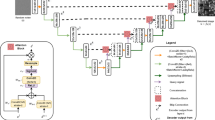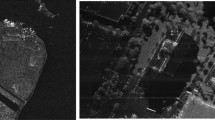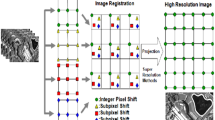Abstract
Restoration and enhancement are crucial preprocessing steps in the satellite domain. Mainly in active remote sensing such as Synthetic Aperture Radar (SAR), the images are more prone to speckle distortions and their reduction is not so trivial. Traditional deep learning models require large training datasets, limiting their applicability. This paper introduces a novel approach that combines the Deep Image Prior (DIP) model with a weighted nuclear norm (WNN) within a variational retinex framework to address these challenges. DIP leverages prior knowledge about noise distribution and works effectively with a single noisy image, eliminating the need for a large number of training images or ground truth. The WNN assigns non-negative weights to singular values, capturing the significance of each value and preserving crucial information during restoration. This approach offers a promising solution for satellite image restoration without relying on huge training data. The proposed method is evaluated through extensive experiments using various image quality metrics, including PSNR, SSIM, ENL, CNR, Entropy, and GCF. The comparative studies provide compelling evidence that the proposed method surpasses existing techniques in effectively restoring and enhancing speckled input images. Furthermore, statistical analysis performed using the Friedman test demonstrates the superior denoising performance of the model. Additionally, an ablation study is conducted to empirically determine the optimal regularization parameters, ensuring the optimal performance of the model. However, the theoretical selection of parameters for achieving optimal results remains an area that requires further exploration.




















Similar content being viewed by others
Data Availability
The data used in the manuscript are freely available for use the source is mentioned in the appropriate locations of the manuscript.
References
Sandia National Laboratories (2021) Pathfinder radar isr & sar systems:sar imagery, Accessed on: 5 December 2021
Wei S, Zeng X, Qu Q, Wang M, Su H, Shi J (2020) Hrsid: A high-resolution sar images dataset for ship detection and instance segmentation. Ieee Access 8:120234–120254
Gonzalez RC (2009) Digital image processing. Pearson education india
Frost VS, Stiles JA, Shanmugan KS, Holtzman JC (1982) A model for radar images and its application to adaptive digital filtering of multiplicative noise. IEEE Transactions on pattern analysis and machine intelligence, pp 157–166
Kuan DT, Sawchuk AA, Strand TC, Chavel P (1985) Adaptive noise smoothing filter for images with signal-dependent noise. IEEE transactions on pattern analysis and machine intelligence, pp 165–177
Lee J-S (1980) Digital image enhancement and noise filtering by use of local statistics. IEEE transactions on pattern analysis and machine intelligence pp 165–168
Srinivasu PN, Balas VE, Norwawi NMd (2021) Performance measurement of various hybridized kernels for noise normalization and enhancement in high-resolution mr images. Bio-inspired Neurocomputing pp 1–24
Seung D, Lee L (2001) Algorithms for non-negative matrix factorization. Adv Neural Inf Process Syst 13:556–562
Candès EJ, Tao T (2010) The power of convex relaxation: Near-optimal matrix completion. IEEE Trans Inf Theory 56(5):2053–2080
Candès EJ, Li X, Ma Y, Wright J (2011) Robust principal component analysis? J ACM (JACM) 58(3):1–37
Liu Y, Jiao LC, Shang F (2013) An efficient matrix factorization based low-rank representation for subspace clustering. Pattern Recognit 46(1):284–292
Srebro N, Jaakkola T (2003) Weighted low-rank approximations. In Proceedings of the 20th international conference on machine learning (ICML-03), pp 720–727
Eriksson A, Van Den Hengel A (2010) Efficient computation of robust low-rank matrix approximations in the presence of missing data using the l 1 norm. In 2010 IEEE Computer society conference on computer vision and pattern recognition, pp 771–778. IEEE
Goldfarb D, Ma S (2011) Convergence of fixed-point continuation algorithms for matrix rank minimization. Found Comput Math 11(2):183–210
Cai J-F, Candès EJ, Shen Z (2010) A singular value thresholding algorithm for matrix completion. SIAM J Optim 20(4):1956–1982
Gu S, Zhang L, Zuo W, Feng X (2014) Weighted nuclear norm minimization with application to image denoising. In Proceedings of the IEEE conference on computer vision and pattern recognition pp 2862–2869
Gu S, Xie Q, Meng D, Zuo W, Feng X, Zhang L (2017) Weighted nuclear norm minimization and its applications to low level vision. Int J Comput Vis 121(2):183–208
Recht B, Fazel M, Parrilo PA (2010) Guaranteed minimum-rank solutions of linear matrix equations via nuclear norm minimization. SIAM Review 52(3):471–501
Xu J, Zhang L, Zhang D, Feng X (2017) Multi-channel weighted nuclear norm minimization for real color image denoising. In Proceedings of the IEEE international conference on computer vision, pp 1096–1104
Candes E, Recht B (2012) Exact matrix completion via convex optimization. Commun ACM 55(6):111–119
Lu C, Tang J, Yan S, Lin Z (2014) Generalized nonconvex nonsmooth low-rank minimization. In Proceedings of the IEEE conference on computer vision and pattern recognition, pp 4130–4137
Yair N, Michaeli T (2018) Multi-scale weighted nuclear norm image restoration. In Proceedings of the IEEE conference on computer vision and pattern recognition, pp 3165–3174
Yu Y, Zhang Y, Yuan S (2019) Quaternion-based weighted nuclear norm minimization for color image denoising. Neurocomputing 332:283–297
Fang J, Liu S, Xiao Y, Li H (2016) Sar image de-noising based on texture strength and weighted nuclear norm minimization. J Syst Eng Electron 27(4):807–814
Volodina OS, Nasonov AV, Krylov AS (2020) Choice of parameters in the weighted nuclear norm method for image denoising. Comput Math Model 31:402–409
Deng H, Tao J, Song X, Zhang C (2020) Estimation of the parameters of a weighted nuclear norm model and its application in image denoising. Inform Sci 528:246–264
Zhao H, Wang C, Li X, Wang J, Liu C, Sheng Y, Huang P (2020) Sar image denoising via fast weighted nuclear norm minimization. In Communications, signal processing, and systems: proceedings of the 2018 CSPS Volume II: signal processing 7th, pp 661–668. Springer
Hoerl AE, Kennard RW (1970) Ridge regression: Biased estimation for nonorthogonal problems. Technometrics 12(1):55–67
Tikhonov A (1963) Regularization of incorrectly posed problems. In Soviet Math Dokl, pp 1624–1627
Rudin LI, Osher S, Fatemi E (1992) Nonlinear total variation based noise removal algorithms. Physica D: Nonlinear Phenomena 60(1–4):259–268
George S, Padikkal J, Remesh K, Argyros IK (2022) A new parameter choice strategy for lavrentiev regularization method for nonlinear ill-posed equations. Mathematics 10(18):1–24
Argyros IK (2022) The theory and applications of iteration methods. CRC Press, USA
Aubert G, Aujol J-F (2008) A variational approach to removing multiplicative noise. SIAM J Appl Math 68(4):925–946
Gilboa G, Osher S (2009) Nonlocal operators with applications to image processing. Multiscale Modeling & Simulation 7(3):1005–1028
Liu X, Huang L (2014) A new nonlocal total variation regularization algorithm for image denoising. Math Comput Simul 97:224–233
Land EH (1977) The retinex theory of color vision. Sci Am 237(6):108–128
Kimmel R, Elad M, Shaked D, Keshet R, Sobel I (2003) A variational framework for retinex. Int J Comput Vis 52(1):7–23
Yang Y, Newsam S (2010) Bag-of-visual-words and spatial extensions for land-use classification. In Proceedings of the 18th SIGSPATIAL international conference on advances in geographic information systems pp 270–279
Ng MK, Wang W (2011) A total variation model for retinex. SIAM J Imaging Sci 4(1):345–365
Zosso D, Tran G, Osher SJ (2015) Non-local retinex–a unifying framework and beyond. SIAM J Imaging Sci 8(2):787–826
Febin IP, Jidesh P, Bini AA (2020) A retinex-based variational model for enhancement and restoration of low-contrast remote-sensed images corrupted by shot noise. IEEE J Selected Topics Appl Earth Obs Remote Sens 13:941–949
Wang P, Zhang H, Patel VM (2017) Generative adversarial network-based restoration of speckled sar images. In 2017 IEEE 7th international workshop on computational advances in multi-sensor adaptive processing (CAMSAP), pp 1–5. IEEE
Hu L, Qin M, Zhang F, Du Z, Liu R (2021) Rscnn: A cnn-based method to enhance low-light remote-sensing images. Remote Sens 13(1):62
Zhang Q, Yuan Q, Li J, Yang Z, Ma X (2018) Learning a dilated residual network for sar image despeckling. Remote Sens 10(2):196
Dalsasso E, Denis L, Tupin F (2021) As if by magic: self-supervised training of deep despeckling networks with merlin. IEEE Trans Geosci Remote Sens 60:1–13
Molini AB, Valsesia D, Fracastoro G, Magli E (2022) Speckle2void: Deep self-supervised SAR despeckling with blind-spot convolutional neural networks. IEEE Trans Geosci Remote Sens 60:1–17
Dalsasso E, Denis L, Tupin F (2021) SAR2sar: A semi-supervised despeckling algorithm for SAR images. IEEE J Selected Topics Appl Earth Obs Remote Sens 14:4321–4329
Dalsasso E, Yang X, Denis L, Tupin F, Yang W (2020) SAR image despeckling by deep neural networks: from a pre-trained model to an end-to-end training strategy. Remote Sens 12(16):2636
Ulyanov D, Vedaldi A, Lempitsky V (2020) Deep image prior. Int J Comput Vis 128(7)
Fan W, Yu H, Chen T, Ji S (2020) Oct image restoration using non-local deep image prior. Electronics 9(5):784
Smitha A, Jidesh P (2021) A nonlocal deep image prior model to restore optical coherence tomographic images from gamma distributed speckle noise. J Mod Opt 68(18):1002–1017
Zhao Z, Xiong B, Wang L, Ou Q, Yu L, Kuang F (2021) Retinexdip: A unified deep framework for low-light image enhancement. IEEE transactions on circuits and systems for video technology
Shastry A, Smitha A, George S, Jidesh P (2022) Restoration and enhancement of aerial and synthetic aperture radar images using generative deep image prior architecture. PFG–Journal of photogrammetry, remote sensing and geoinformation science pp 1–33
Yang H, Li J, Shen L, Lu J (2020) A convex variational model for restoring sar images corrupted by multiplicative noise. Mathematical Problems in Engineering 2020
Merced University of California (2022) Merced 2020: Aerial photos. Accessed on: 2 January 2022
Jet Propulsion Laboratory (2021) Space radar image of flevoland, netherlands Accessed on: 5 December 2021
Lopes A, Touzi R, Nezry E (1990) Adaptive speckle filters and scene heterogeneity. IEEE Trans Geosci Remote Sens 28(6):992–1000
Parrilli S, Poderico M, Angelino CV, Verdoliva L (2011) A nonlocal sar image denoising algorithm based on llmmse wavelet shrinkage. IEEE Trans Geosci Remote Sens 50(2):606–616
Johnson DH (2006) Signal-to-noise ratio. Scholarpedia 1(12):2088
Wang Z, Bovik AC, Sheikh HR, Simoncelli EP (2004) Image quality assessment: from error visibility to structural similarity. IEEE Trans Image Process 13(4):600–612
Gomez L, Ospina R, Frery AC (2017) Unassisted quantitative evaluation of despeckling filters. Remote Sens 9(4):389
Timischl F (2015) The contrast-to-noise ratio for image quality evaluation in scanning electron microscopy. Scanning 37(1):54–62
Karathanassi V, Kolokousis P, Ioannidou S (2007) A comparison study on fusion methods using evaluation indicators. Int J Remote Sens 28(10):2309–2341
Matkovic K, Neumann L, Neumann A, Psik T, Purgathofer W, et al (2005) Global contrast factor-a new approach to image contrast. In CAe pp 159–167
Friedman M (1937) The use of ranks to avoid the assumption of normality implicit in the analysis of variance. J Am Stat Assoc 32(200):675–701
Austria DATAtab (2023) e.U. Graz. Datatab: Online statistics calculator, Accessed on: 1 July 2023
Funding
The Authors would like to thank Science and Engineering Research Board, Govt. of India for providing financial support under grant no. CRG/2020/000476.
Author information
Authors and Affiliations
Corresponding author
Ethics declarations
Conflicts of interest
The authors declare no conflict of interest for the materials contained in this manuscript.
Additional information
Publisher's Note
Springer Nature remains neutral with regard to jurisdictional claims in published maps and institutional affiliations.
Appendices
Appendix
A bayesian MAP estimator for gamma noise
In this section, the MAP estimation of Gamma noise is provided in detail. The authors in [33] derived the fidelity term for the gamma noise by maximizing the posterior probability of obtaining a clean estimate given noisy data. The extract of the same is provided here for completeness. According to Bayes’ theorem, the posterior probability P(X|Y) is defined as given in (A1),
where, X and Y represent random variables and P(X|Y) represents the conditional probability i.e. the probability of X given Y. In the imaging domain, we model the observed data as \(P(u_0|u)\), where u and \(u_0\) are the original and distorted images, respectively. MAP estimator maximizes the posterior probability \(P(u|u_0)\) and the (A1) takes the form as in (A2),
P(u) is the prior probability. \(P(u_0)\) is a constant that represents total probability. This term is omitted in the further steps as it doesn’t affect the minimization process. Minimizing the (A2) is equivalent to maximizing its negative \(\log \) likelihood ((A3), as log is a monotonic function),
Under the assumption that the noise samples are mutually independent of each other, the likelihood estimate is given by the product of sum terms denoted as in (A4),
For Gamma distribution, \( P(u_0|u) = \prod _{i}\frac{L^L}{u(i)^L\Gamma (L)} u_0(i)^{L-1} e^{-\frac{Lu_0(i)}{u(i)}}\) where L stands for the number of looks. Assuming the Gibb’s prior, \(P(u) = e^{-\lambda _k\phi (u)}\), the minimization function in (A3) is defined as shown in (A5),
For the sake of simplicity, we drop the index term "i". For a continuous function u (after dropping the index i), the minimization term in the image domain \(\Omega \) is written as shown in (A6),
B Image quality metrices
Various reference and non-reference-based matrices used for the quantitative evaluation are detailed below.
1.1 B.1 Reference based IQM
Reference-based measures rely on ground truth data for the evaluation of the restored image quality.
1.1.1 B.1.1 peak signal to noise ratio
PSNR measures the signal-to-noise ratio. It quantifies the extent of denoising in an image. Using the same notations as in (11), PSNR is defined as in (B1),
where, \(\mathcal {M}_u\) is the maximum possible pixel value in the image u and MSE represents the corresponding mean square error defined as (B2),
If the noisy or the restored image varies significantly from the clean image, then MSE increases, leading to a lesser PSNR. As the noise decreases in the image, the PSNR value increases conveying better denoising and restoration.
1.1.2 B.1.2 structural similarity measure
SSIM analyses the noise reduction, structure and contrast preservation. It signifies the closeness or similarity of two images under consideration. SSIM is evaluated as as given in (B3),
where, where \(\mu _u\), \({\mu _u}_0\) denotes the mean and \({s_u}\),\({s_u}_0\) denote the variance of u, \(u_0,\) respectively.
1.2 B.2 Non-Reference based IQM
These are the blind quality metrics that rely only on noisy data to evaluate the quality of the restored image.
1.2.1 B.2.1 Equivalent Number of Looks
ENL is calculated on the homogeneous patches in the images where the intensity variation is minimum (only variation can be because of noise). The smaller the variance is, the larger is the ENL value, which indicates a better despeckled image. ENL is defined as in (B4),
where \(\mu _p\) and \(s_p^2\) represent patch mean and variance respectively.
1.2.2 B.2.2 contrast to noise ratio
It quantifies the contrast factor along with the denoising, similar to the PSNR. It is computed as mentioned in (B5),
where \(\mu _p\), \(\mu _n\), and \(s_p\), \(s_n\) represent the mean and variance of the reconstructed and noisy samples, respectively.
1.2.3 B.2.3 Entropy
The entropy measure assesses the information gain. The value of the entropy depends on the intensity distribution of the pixels in an image. It is defined as specified in (B6),
The entropy can get its minimum value of 0 for the homogeneous region(ideally no variation in the pixels) because for such regions, \(P(i) = 1\) and \(\log 1 = 0\)). The higher entropy is achieved when the image is heterogeneous.
1.3 B.3 global contrast factor
GCF corresponds to the human perception of contrast. GCF is evaluated as given in (B7),
where, \(\alpha _i\) is the weight associated with the local average contrast \(\mathcal {C}_i\). \(lc_j\) is the average local contrast of pixels in the image of size \(width\times height\). N is the total number of iterations for which the local average is measured.
Rights and permissions
Springer Nature or its licensor (e.g. a society or other partner) holds exclusive rights to this article under a publishing agreement with the author(s) or other rightsholder(s); author self-archiving of the accepted manuscript version of this article is solely governed by the terms of such publishing agreement and applicable law.
About this article
Cite this article
Shastry, A., Jidesh, P., George, S. et al. A weighted nuclear norm (WNN)-based retinex DIP framework for restoring aerial and satellite images corrupted by gamma distributed speckle noise. Multimed Tools Appl 83, 37927–37959 (2024). https://doi.org/10.1007/s11042-023-17159-y
Received:
Revised:
Accepted:
Published:
Issue Date:
DOI: https://doi.org/10.1007/s11042-023-17159-y




